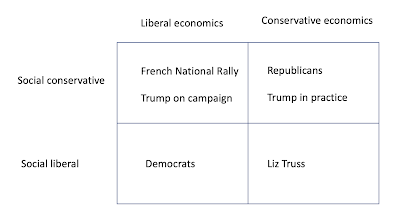A few weeks ago, Ross Douthat asked "How does a party that historically represented the rich and big business adapt to a world where conservatism’s constituencies are not just middle class but blue-collar, downscale and disappointed with the modern American economy?" My answer is in the title to this post. In late 2020 I wrote about a question that had been asked a number of times between 1987 and 1996 and then again in October 2017: "in general, do you think that the [Democratic/Republican] Party favors the rich, favors the middle class, favors the poor, or does it treat them all the same." I compared a couple of surveys from the first period to the 2017 survey, and noted that the perceptions of (self-described) Republicans had changed: in the 1980s and 1990s, about 30% said that the Republican party favored the rich; in 2017, that had fallen to 12%. At the same time, the percent of Republicans who said that the Democrats favored the rich went from 18% in 1987 to 24% in 1996 to 34% in 2017. This post will look at the same data from another angle.
The 1996 survey had a question about vote in a hypothetical race involving Dole vs. Clinton (omitting Perot) and the 2017 survey had a question about vote in the 2016 election. I regressed this on dummy variables representing perceptions of the parties: Republicans favor the rich, the middle class, and the poor, and Democrats favor the rich, the middle class, and the poor ("treat them all the same" is reference category for both). The estimates, predicting the chance of Republican support:
1996 2017
R Rich -2.2 -3.7
R Middle -0.3 -0.0
D Rich 1.8 2.0
D Middle 0.2 0.0
D Poor 2.0 1.9
Same 0.7 0.6
The standard errors are all around 0.3 in 1996, and about 0.3 to 0.5 in 2017. I omit the estimates for people who thought the Republicans favored the poor--very few people believed that, so the standard errors were very large. "Same" is people who gave the same rating to both parties (e. g., said that both favored the rich). They were somewhat more likely to favor the Republican candidate, which could be the result of a Republican advantage on perceptions of competence or non-economic issues.
At both times, being seen as favoring the rich (as opposed to the middle class or poor) hurt both parties, and being seen as favoring the poor hurt the Democrats. All of the estimates were about the same at both times except for Republicans favoring the rich, which was almost twice as big in 2017: that is, a perception that the Republicans favored the rich was more damaging in 2017.
Of course, the relationship could go in either direction: people could form perceptions of the parties and use them in deciding how to vote, or people could decide who to vote for and adjust perceptions to support their decision. It seems safe to say that both are involved, but my guess is that the second one is more important. That is, there's been a change in the way that Republican voters rationalize their decision: they are increasingly unwilling to see their party as favoring the rich. Several years ago, I proposed that there had been a growth of social egalitarianism, and that at one time "Republicans thought of themselves as the party of successful people. Now both parties think of themselves as the party of the common people, plus the fraction of the elites who care about or understand the common people." I think these results support that analysis.
Returning to Douthat's question, why haven't Republicans responded to the changes in party support by shifting their policies? One reason is ideology--both in the positive sense of an attachment to tax and spending cuts and the negative sense of a dislike for anything associated with "the left." Another is that "downscale" (less educated) voters are shifting towards the Republicans anyway. This has been going on for a long period of time, and doesn't seem to be closely connected to changes in party policy. So rather than making changes in policy, party leaders can congratulate themselves on being "the party of the working class" (and on being unpopular among "elites") while following the same policies as before.
PS: here is the trend on beliefs about favoring the rich in the whole sample (Democrats, independents, and Republicans):
There's no clear change for Republicans, and some evidence of an increase for the Democrats (the Pearson correlation with time is .73, and the Spearman correlation is .65).
[Data from the Roper Center for Public Opinion Research]



